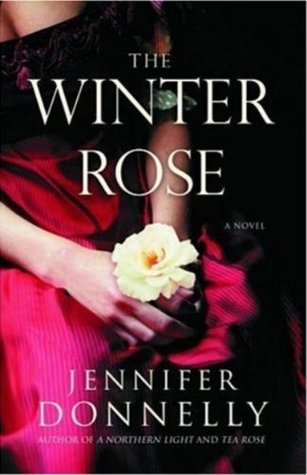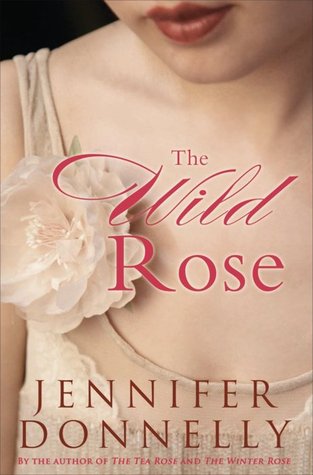Search the Blog
Categories
- Books & Reading
- Broadband Buzz
- Census
- Education & Training
- Friday Reads
- General
- Grants
- Information Resources
- Library Management
- Nebraska Center for the Book
- Nebraska Libraries on the Web
- Nebraska Memories
- Now hiring @ your library
- Preservation
- Pretty Sweet Tech
- Programming
- Public Library Boards of Trustees
- Public Relations
- Talking Book & Braille Service (TBBS)
- Technology
- Uncategorized
- What's Up Doc / Govdocs
- Youth Services
Archives
Subscribe
Tag Archives: Friday Reads
Friday Reads: The Missing Ink by Karen E. Olson
I don’t usually read mysteries. I’m more into sci fi/fantasy. But, I am willing to go outside of my usual tastes when something interesting catches my attention. That’s how I ended up with The Missing Ink, and its sequels, on my bookshelf.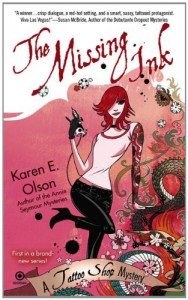
The Missing Ink is the first book in the Tattoo Shop Mysteries, by Karen E. Olson. There are four books in total in the series, and yes, I’ve read them all.
What drew me to these books? Well, the main character is a woman, Brett Kavanaugh, the owner of a tattoo shop in Las Vegas. That was pretty much all it took. Strong, independent female lead, owns her own business, which just happens to be a tattoo parlor. I was cautiously hooked. As I said, I don’t usually go for mysteries, so that was a bit of a stretch for me. And I was also concerned that some annoying romance factor would be awkwardly shoehorned into the books, just because ‘that’s what women like to read about’. Well, no, not me. But, it looked like a quick read, so I decided to try it out anyway.
And, I liked it! I’ve seen this series described as ‘cozy mystery’ – since I’m not a regular mystery reader, I wasn’t exactly sure what that should mean. But, it was definitely fun and fast paced – yes, a real ‘page-turner’ as they say. The Las Vegas setting was well developed and the intricate plot really drew me in. And although there was a hint of ‘romance’, it wasn’t Brett’s main concern in life, it was actually portrayed much more realistically, in my opinion. As an aside, not something that she becomes stupidly obsessed with. Because you know, there are murders happening, and that’s what the story is really about.
At the end of this book, I definitely wanted more. Unfortunately, I read The Missing Ink soon after it was first published in 2009, so I had to wait impatiently for the sequels. But the series is complete now – as far as I can tell, Olson isn’t planning on writing any more Tattoo Shop Mysteries. So, you’re in luck – you can read the entire series all at once!
Friday Reads: School for Brides & Keeping the Castle, by Patrice Kindl
I recently finished A School for Brides by Patrice Kindl, a new companion title to her Keeping the Castle which came out in 2012. I might be cheating by talking about two books, but they certainly go hand-in-hand.
 Keeping the Castle is reminiscent of Pride and Prejudice with a touch of Cinderella – due to stepsisters. Seventeen-year-old Althea knows the only way to save her family’s decaying castle, its grounds, and their tenants for her widowed mother and much younger brother is to marry well. The two unkind stepsisters living with them could contribute funds to reduce the costs but choose to complain instead. Althea has an unfortunate habit of speaking her mind which makes finding a suitor much more difficult; she would prefer to remain single if it wasn’t so necessary to wed. She does what she can to aid her new friend, Miss Vinchy, in finding a match, but doesn’t seem to make any progress for herself. Readers will see the possibilities long before Althea does, which adds to the fun. Romance, proper behavior of the time and surprises are included.
Keeping the Castle is reminiscent of Pride and Prejudice with a touch of Cinderella – due to stepsisters. Seventeen-year-old Althea knows the only way to save her family’s decaying castle, its grounds, and their tenants for her widowed mother and much younger brother is to marry well. The two unkind stepsisters living with them could contribute funds to reduce the costs but choose to complain instead. Althea has an unfortunate habit of speaking her mind which makes finding a suitor much more difficult; she would prefer to remain single if it wasn’t so necessary to wed. She does what she can to aid her new friend, Miss Vinchy, in finding a match, but doesn’t seem to make any progress for herself. Readers will see the possibilities long before Althea does, which adds to the fun. Romance, proper behavior of the time and surprises are included.
A School for Brides is set in the same time and place – the early 1800s in the town of Lesser Hoo in Yorkshire England – and some of the characters from the first book make secondary appearances here. The eight young ladies of the Winthrop Hopkins Female Academy study their lessons in math, French, comportment and stitching; but their real purpose at the school is for each to find a husband. Too bad Lesser Hoo has only one sort-of-eligible bachelor. Things look up when a young well-to-do gentleman is thrown from his horse. A broken leg necessitates his stay at the school and soon some of his friends come to visit. Manners of the day, social standing, treatment of household staff and the winning or losing of ladies’ hands are all addressed. A couple of mysteries and some ne’er-do-wells in the mix make a humorous and gratifying tale.
in the town of Lesser Hoo in Yorkshire England – and some of the characters from the first book make secondary appearances here. The eight young ladies of the Winthrop Hopkins Female Academy study their lessons in math, French, comportment and stitching; but their real purpose at the school is for each to find a husband. Too bad Lesser Hoo has only one sort-of-eligible bachelor. Things look up when a young well-to-do gentleman is thrown from his horse. A broken leg necessitates his stay at the school and soon some of his friends come to visit. Manners of the day, social standing, treatment of household staff and the winning or losing of ladies’ hands are all addressed. A couple of mysteries and some ne’er-do-wells in the mix make a humorous and gratifying tale.
I greatly enjoyed both books, the setting, the humor, and the writing; the author has provided two enjoyable Jane Austen-like capers. They are a fun and lovely change from the many teen dystopia and/or killer suspense novels I have been reading lately. They will be enjoyed by teens and adults.
Friday Reads: After the Golden Age by Carrie Vaughn
This year’s Summer Reading Program is “Every Hero Has a Story” (or “Escape the Ordinary” for us older folks). After the Golden Age caught my eye as I passed a display of hero- themed books at my local library. I’m not typically a reader of graphic novels or the Marvel Universe, but I enjoy fantasy and science fiction, and this book has a bit of romance and family drama thrown into the mix.
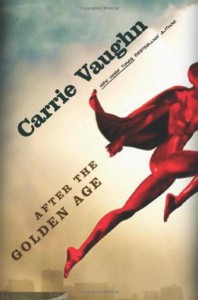
It takes super powers to be a hero. At least that’s what Celia West assumes. After all, she’s the daughter of Captain Olympus and Spark, the superhuman crime-fighters that lead Commerce City’s vigilante team, the Olympiad. Much to their disappointment, Celia didn’t inherit her father’s super strength or her mother’s pyrokinesis. Instead, she seems destined to be a target for city’s villains; she’s been kidnapped so many times, she wonders if she should change her name to “The Captive Wonder.”
After a youthful indiscretion, Celia tries to make a normal life for herself as a forensic accountant, away from her parents and out of the Olympiad’s shadow. Our story begins when Celia is asked to assist with the tax-evasion trial of The Destructor, the city’s most notorious supervillain and her parent’s archenemy. Will Celia be able to take down the criminal mastermind that neither her parents nor the police could ever defeat? Or will her involvement in the trial be just the public distraction the mayor needs to rid Commerce City of its meddlesome superheroes? It’s up to Celia to save the day.
Friday Reads: The Story of Edgar Sawtelle, by David Wroblewski
Sometimes we choose a book; sometimes a book finds us. The latter is what happened with David Wroblewski’s The Story of Edgar Sawtelle. An elderly neighbor who had recently lost his wife and who was cleaning out the house before moving to Florida offered me two books including this one. 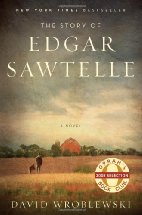
This novel tells the story of Edgar, son of parents who raise and train a breed of dog named after the family. For no explicable reason Edgar can hear but is unable to speak. Because of this he trains dogs using signs (and sign language), while his mother uses voice commands.
The story revolves around the death of Edgar’s father (in which Edgar suspects his uncle, Claude) and the accidental death (in which Edgar had a part) of a beloved veterinarian who cares for the family’s dogs. The latter event impels Edgar to run away for two months with three dogs he has raised. His survival in a wilderness area, the appearance of another character who helps him, and his eventual return home to confront his uncle all lead the story along at a good pace for the reader.
Perhaps the most fascinating part of the book is when the author, employing the “omniscient” voice, tells part of the story from the dog’s perspective. This is especially poignant when Almondine (present at the birth of Edgar and with whom Edgar has a special bond), is facing the end of her life, wondering why her beloved Edgar has left and not returned. It is heart-breaking, but then I am a lover of dogs, so that may have something to do with it. (Note that the author read up on canine cognition in preparing to write the book.)
This book was a 2008 selection of Oprah’s Book Club. (All of us in the library field owe Oprah a debt of gratitude for her support and promotion of book clubs.) If you like dogs and a good mystery, you’ll enjoy this book.
If you are interested in this title for your book club, the Commission has it available for check out. Go to following link to accomplish that:
http://nlc.nebraska.gov/ref/bookclub/
Richard Miller
Friday Reads: Sweetness at the Bottom of the Pie by Alan Bradley
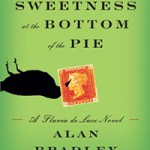 If you enjoy mysteries, chemistry, sibling rivalry, and an unforgettable protagonist, then Sweetness at the Bottom of the Pie by Alan Bradley is for you! Flavia de Luce, an 11 year old, roams the old English countryside of about 1950 in hopes of clearing her father in a murder investigation. Flavia is found interviewing suspects, gathering clues, and compiling research at the library, always staying ahead of Inspector Hewitt and the police department. She specializes in toxins and goes as far as to slightly poison her sisters’ lipstick. The country manor home has many-an-interesting character working in it, surrounding it, or as part of its history. If you are a stamp collector you may have knowledge of the Penny Black stamp which plays a vital role in the capture of the true killer. You will laugh out loud as you follow Flavia through her deductions, and maybe you will beat her to the “solution” I sure did not. I understand that our amateur sleuth will be with us for a while as this is the first in a proposed 10-book series http://alanbradleyauthor.com/books/.
If you enjoy mysteries, chemistry, sibling rivalry, and an unforgettable protagonist, then Sweetness at the Bottom of the Pie by Alan Bradley is for you! Flavia de Luce, an 11 year old, roams the old English countryside of about 1950 in hopes of clearing her father in a murder investigation. Flavia is found interviewing suspects, gathering clues, and compiling research at the library, always staying ahead of Inspector Hewitt and the police department. She specializes in toxins and goes as far as to slightly poison her sisters’ lipstick. The country manor home has many-an-interesting character working in it, surrounding it, or as part of its history. If you are a stamp collector you may have knowledge of the Penny Black stamp which plays a vital role in the capture of the true killer. You will laugh out loud as you follow Flavia through her deductions, and maybe you will beat her to the “solution” I sure did not. I understand that our amateur sleuth will be with us for a while as this is the first in a proposed 10-book series http://alanbradleyauthor.com/books/.
Friday Reads: Leaving the Pink House: A Memoir, by Ladette Randolph
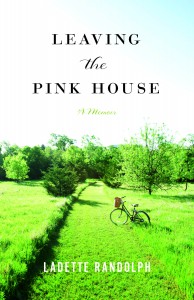 Friday Reads: Leaving the Pink House: A Memoir, by Ladette Randolph
Friday Reads: Leaving the Pink House: A Memoir, by Ladette Randolph
The voyeur in me loves to read a good memoir and to snoop through other people’s houses. Even though I may talk a lot about the recent Masterpiece Theatre public television offering, House Hunters is one of my secret guilty pleasures. Leaving the Pink House: A Memoir by Ladette Randolph offers both the great memoir and the opportunity to poke around in various houses that the author lived in throughout her life. And it offers a lot more. I’ve read other books by this author so I was prepared for her careful, sparse, lovely writing. I might not have been prepared for how much the story of her life grabbed me and touched me.
I devoured the sections of the book that detail the remodeling project that compelled Randolph and her husband to leave the pink house (their previous remodeling project). The realistic descriptions of the planning, decision-making, and execution required in the remaking of their country home seem to mirror the internal remaking that was going on in their family. And anyone that has undertaken a home remodel can identify with that. Not to get all “pop-psychology” here, but our images of house and home really might reflect our sense of self—as suggested by Freudian and Jungian dream analysis.
“Renovating a house requires intimacy with a building. By time you’ve stripped wallpaper, pulled up carpets, removed cabinets, washed, sanded, and painted walls and woodwork, you know the lines and features of a house as you might the body of a lover. Our level of approaching intimacy with the country house, though, was less like that of a lover than like that of a forensic scientist.” (P. 61)*
I love that the sections on the remodeling project are interspersed with chapters that inform us about the author by reflecting on her life in previous homes. On the surface, the story seems to progress through the various homes that Randolph inhabited throughout her life, but below the surface she explores the relationships those homes sheltered and the different person she was as she lived in each of those homes. I know the author—a little bit—and I confess that might make this memoir even more enticing. I only know her as a snapshot in time. The revelation of her past life in the chapters of this book really surprised me. It reminded me that we may not really know that much about our acquaintances and colleagues. It reminded me that delving into another person’s life can uncover depths of beauty, but sadness too. Learning about another person’s journey can help us examine our own. Could that be the real appeal of House Hunters?
*Leaving the Pink House: A Memoir, by Ladette Randolph, University Of Iowa Press; 1 edition (September 1, 2014)
Friday Reads: The Life-Changing Magic of Tidying Up: The Japanese Art of Decluttering and Organizing, by Marie Kondo
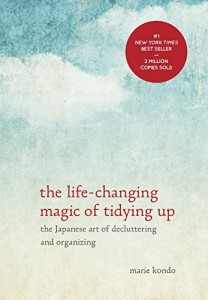 I am pretty much what my grandmother used to call a “mess pot.” Despite dozens of bins, drawer organizers, labeled shelves, color-coded files, and all my good intentions, my place is mostly a jumble. So, hope springing eternal, when I heard about this book, I knew that I had to read it.
I am pretty much what my grandmother used to call a “mess pot.” Despite dozens of bins, drawer organizers, labeled shelves, color-coded files, and all my good intentions, my place is mostly a jumble. So, hope springing eternal, when I heard about this book, I knew that I had to read it.
Yes, I was looking for a silver bullet—that one quick, easy, wonderful thing that would transform my life, or at least keep shoes from accumulating under the coffee table. Any book that offered “life changing magic,” well, it wasn’t a wand from Olivander’s, but I was ready to try it.
It’s a little book, didactic (perhaps the result of the translation from Japanese) and charming by turns. Taken literally, I thought it was kind of nuts. Ms. Kondo requires things to be done in very specific ways—and her ways wouldn’t necessarily fit with my mental processes or lifestyle. There are YouTube videos, and plenty of articles and reviews that illustrate. But the spirit of her advice resonated for me:
- Decide what you are going to keep, don’t decide what you are going to discard.
- Keep only those things that “spark joy.”
- Many things are not meant for forever. If something’s time has passed, it’s okay to discard it.
- Most papers can be thrown away.
- Tackle organizing and purging by category of items, not by location.
- Appreciate the things you have and care for them.
- Store things in ways that make them easy to find and access.
- Develop habits that make it easy to maintain orderliness.
I felt that the underlying message was to practice mindfulness, to not be overly materialistic, and to make sure that possessions were working for me, not burdening me. So for me, the attitudes were more valuable than the specific methods—although her way of folding and organizing an underwear drawer was pretty slick.
Friday Reads: Big Bad Love by Larry Brown
 Two of my favorite authors are Raymond Carver and Charles Bukowski. Both are blue collar writers who encapsulate the mundane, disturbing, hapless, and tragic parts of everyday lives. Often, there is a great deal of humor underneath or simultaneously with these tragedies. Until recently, I had no idea that there is a term for this style and type of writing. It’s called “dirty realism.” The writing focuses more on the pain and suffering rather than the warm and fuzzy; the unhappiness rather than the happy; the trivial rather than the substantive. Both Carver and Bukowski have a very distinctive L.A. feel; although Bukowski was more skid row than Carver. Listen to some Tom Waits while you read either and you’ll feel right at home (I’d recommend Frank’s Wild Years and/or Swordfishtrombones). Now, before I get to rambling (or to put an end to it here and now), this Friday Reads isn’t about Carver or Bukowski. The problem is that I’ve already read their stuff (they are both dead), and for years have been searching for something with a similar feel. I finally found it when I discovered Larry Brown. Unfortunately, Larry Brown also died in 2004, but since I have yet to read any of his stuff, I feel refreshed. Well, sort of.
Two of my favorite authors are Raymond Carver and Charles Bukowski. Both are blue collar writers who encapsulate the mundane, disturbing, hapless, and tragic parts of everyday lives. Often, there is a great deal of humor underneath or simultaneously with these tragedies. Until recently, I had no idea that there is a term for this style and type of writing. It’s called “dirty realism.” The writing focuses more on the pain and suffering rather than the warm and fuzzy; the unhappiness rather than the happy; the trivial rather than the substantive. Both Carver and Bukowski have a very distinctive L.A. feel; although Bukowski was more skid row than Carver. Listen to some Tom Waits while you read either and you’ll feel right at home (I’d recommend Frank’s Wild Years and/or Swordfishtrombones). Now, before I get to rambling (or to put an end to it here and now), this Friday Reads isn’t about Carver or Bukowski. The problem is that I’ve already read their stuff (they are both dead), and for years have been searching for something with a similar feel. I finally found it when I discovered Larry Brown. Unfortunately, Larry Brown also died in 2004, but since I have yet to read any of his stuff, I feel refreshed. Well, sort of.
Like much (if not all) of Carver’s work, Larry Brown’s Big Bad Love is a collection of short stories. There are similarities, but Brown lived in Oxford, Mississippi, so the stories have a different, non-California feel to them. The stories are written from a male perspective, filled with alcoholics, depression, and tales of dysfunctional or failed relationships. I found the stores to be relatable (on some levels) and often hilarious. There is, however, a fine line between laughing at another’s misery and laughing with them. I had the latter feeling. There is something to say about retaining your sense of humor during life’s tragedies, and I think Brown aptly captures that, at least in part 1. Part 2 of the book consists of a longer story. I wouldn’t even recommend reading it. Compared to part 1, it’s a bore. Here’s a quote from part 1 that provides a snippet of Brown’s style:
“I didn’t know why something that started off feeling so good had to wind up feeling so bad. Love was a big word and it covered a lot of territory. You could spend your whole life chasing after it and wind up with nothing, be an old bitter guy with long nose hair and ear hair and no teeth, hanging out in bars, looking for somebody your age, but the chances of success went down then. After a while you got too many strikes against you.”
Friday Reads: The Bone Clocks by David Mitchell
 The Bone Clocks moves along quicker than The Cloud Atlas, by the same author, and seems to flow better, in my opinion. It begins in 1980 with Holly Sykes, a 15-year-old London girl, who has an ugly row with her mother, then the earth shattering betrayal by her older, illegal, boyfriend and her best friend. Then she runs away.
The Bone Clocks moves along quicker than The Cloud Atlas, by the same author, and seems to flow better, in my opinion. It begins in 1980 with Holly Sykes, a 15-year-old London girl, who has an ugly row with her mother, then the earth shattering betrayal by her older, illegal, boyfriend and her best friend. Then she runs away.
But she can’t run away from the radio people. The paranormal entities that she’s been hearing and been in contact with much of her life. And she isn’t just hearing things. They’re real. The genius of this writer is that he’s writing perfectly fine real life coming of age story, war story, writer’s life story and then in walks the paranormal, and it’s not the one you think it’ll be from all your mystery or horror reading. Eventually you learn who the sides are. Both are immortal, One “eats” the gifted souls to live eternally, carnivores, or Anchorites. The other dies natural deaths and continues on, only if not killed unnaturally, the Horologists, following a script (as in a play.)
Slowly, we go through personal stories of each individual, with sudden steps into the paranormal. Each interweaves with the other, a 14-year-old girl, a war correspondent, a young con man, a literary writer, and more. Getting closer to an event of proportions we cannot guess. But it will change lives.
Review by William Skidelsky in the Gaurdian
Review by Derek Thompson in the Atlantic
Friday Reads: The Tea Rose Trilogy by Jennifer Donnelly
From Library Journal:
In The Tea Rose, it is “1888, and Fiona Finnegan and Joe Bristow hoard shillings and pennies so that they can marry and open a shop. But Jack the Ripper stalks the streets of London’s East End, and poverty threatens from the shadows. Setting the story in motion is the murder of Fiona’s father, a dock worker whose union activities angered his tea-company boss. Fiona and her younger brother must flee to New York City to avoid their own murders. Through hard work and luck, Fiona and her beloved Joe prosper on opposite sides of the Atlantic. Misunderstandings and mistakes keep them apart as they build separate lives and incredible fortunes. Children’s book writer Donnelly effortlessly takes her narrative through slums and high society while intertwining a number of subplots without tangling them. Both major and minor characters capture and hold interest and sympathy. ”
The Winter Rose, the second book in the Tea Rose Trilogy, begins “in late Victorian London. Idealistic new medical school graduate India Selwyn Jones goes to work at a clinic in the city’s poorest neighborhood, much to the dismay of her aristocratic mother and ambitious fiancé, political up-and-comer Freddie Lytton. The squalor is a bit much for India, but she manages to keep her emotions under control until she meets underworld crime boss Sid Malone. Sid begins as India’s nemesis, becomes her patient and ends up something much more than that. What India doesn’t know is that Sid is the brother of tea heiress Fiona Bristow, wife of self-made, highly principled businessman Joseph Bristow. What Sid doesn’t know is that India’s fiancé is as ruthless as Sid’s most ruthless henchman, willing to commit theft, betrayal and even murder to launch his career, force India out of hers and bring down Sid in the process.”
From Hachette:
In the third Tea Rose Trilogy book, The Wild Rose, “it is London, 1914. World War I looms on the horizon, women are fighting for the right to vote, and explorers are pushing the limits of endurance in the most forbidding corners of the earth. Into this volatile time, Jennifer Donnelly places her vivid and memorable characters: Willa Alden, a passionate mountain climber who lost her leg while summiting Kilimanjaro with Seamus Finnegan, and who will never forgive him for saving her life; Seamus Finnegan, a polar explorer who tries to forget Willa as he marries a beautiful young school teacher back home in England; Max von Brandt, a handsome German sophisticate who courts high society women, but has a secret agenda in wartime London.”
I listened to the audio versions of these books. They are all narrated by Jill Tanner, who does a wonderful job with all of the character’s voices. Whether you read the book, or listen to the audio version, I’m sure you will find this historical fiction saga as enjoyable as I did.
Friday Reads: Fahrenheit 451 by Ray Bradbury
“Somewhere the saving and putting away had to begin again and someone had to do the saving and keeping, one way or another, in books, in records, in people’s heads, any way at all so long as it was safe, free from moths, silver-fish, rust and dry-rot, and men with matches.”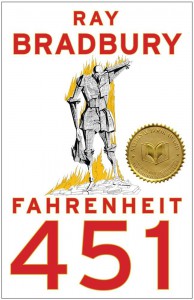
I find it somewhat hard to believe that I haven’t read Fahrenheit 451 until now. In addition to its status as a classic, it would seem that, given, my chosen profession, I’d have managed to read it already. As the above quote illustrates, the message of this book should appeal to librarians.
Before I started reading this book, I was familiar with the general premise, a dystopian future in which books are outlawed. The book’s protagonist is Guy Montag, who works as a fireman. In this future society, firemen don’t put out fires; they set them, in order to burn illicit books. Montag becomes increasingly dissatisfied with the state of the society in which he lives, and he takes steps to oppose the status quo.
I’ve been very pleasantly surprised at how much I’m enjoying finding out all the details of this book that has existed in my consciousness only as a cultural icon all this time. I think it is very well-written, and I love Bradbury’s prose. Although the book was originally published in the 1950s, I find many of its descriptions of everyday life and technology very similar to our current society. Reading about how, instead of interacting with one another, people focus their attention on televisions that take up three walls of their living rooms and constantly listen to earphones made me feel guilty about the amount of time I spend mindlessly using my TV, tablet, and iPod. (However, I did use my iPod to listen to this audiobook, so maybe electronic devices are not all bad!)
The particular audiobook I am listening to is narrated very well by actor Tim Robbins, which adds to my enjoyment. Robbins does a great job of bringing Montag to life and provides distinguishable, believable voices for the supporting characters.
Bradbury, Ray. Fahrenheit 451. Newark, NJ: Audible Studios, 2014.
Friday Reads: Kitchen Confidential: Adventures in the Culinary Underbelly, by Anthony Bourdain
 I remember hearing buzz about Kitchen Confidential, Anthony Bourdain’s account of what it’s like to work in a restaurant kitchen, shortly after it was published in the summer of 2000. Interviews and reviews that surfaced in the media piqued my interest, but I never got around to reading it at the time. Since then Bourdain’s fame has grown due to his participation in several television series, most notably No Reservations and Parts Unknown. Finally, last week, my husband checked out the eBook edition from Lincoln City Libraries’ OverDrive collection. He laughed so hard he cried as he consumed it nightly before bed, interrupting my reading to share excerpts so frequently that I felt compelled to check out, download, and listen to the audiobook edition, read by Bourdain, himself.
I remember hearing buzz about Kitchen Confidential, Anthony Bourdain’s account of what it’s like to work in a restaurant kitchen, shortly after it was published in the summer of 2000. Interviews and reviews that surfaced in the media piqued my interest, but I never got around to reading it at the time. Since then Bourdain’s fame has grown due to his participation in several television series, most notably No Reservations and Parts Unknown. Finally, last week, my husband checked out the eBook edition from Lincoln City Libraries’ OverDrive collection. He laughed so hard he cried as he consumed it nightly before bed, interrupting my reading to share excerpts so frequently that I felt compelled to check out, download, and listen to the audiobook edition, read by Bourdain, himself.
Early in the book Bourdain describes the life lived by restaurant kitchen workers as a subculture. From his anecdotes, which my husband swears aren’t exaggerations (he cooked for two years while I attended library school), that sounds spot on. This is not a ponderous or philosophical book, though Bourdain does share interesting insights and opinions. The prose is raw, in-your-face, and eloquently crude. As Bourdain reads his own words one imagines this is just the way he speaks in real life, when not restrained by television censors. If profanity bothers you, this is not the book for you!
By the end of the book any illusions the reader might have had that cooking for a living is glamorous will have been completely shattered. Bourdain paints a picture of a physically and psychically hard life, where drug addiction and dysfunction reign. Kitchen crews are described at various times as pirate crews and mercenaries. It wouldn’t be the life for me, but I enjoyed reading about it!
Bourdain, Anthony. Kitchen Confidential: Adventures in the Culinary Underbelly. Penguin Random House Audio Publishing Group, 2001. Internet resource. (Listen to sample)
Friday Reads: Nemesis by Jo Nesbo
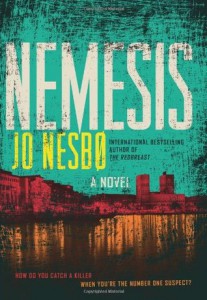 Along with millions of others, I am a fan of Stieg Larsson’s “Millenium” trilogy of crime novels. Seriously, is there a more compelling character than Lisbeth Salander? Those were the first novels I’d read by a Scandinavian author. Having enjoyed Larsson’s series I was curious to learn more about Jo Nesbo, a popular Norwegian author who writes crime fiction – a lot of crime fiction. Harry Hole is the main character in a series of, so far, ten crime novels written by Nesbo. Hole is described as a “classic loose cannon” in the Oslo (Norway) police force. He’s flawed, but, of course, brilliant.
Along with millions of others, I am a fan of Stieg Larsson’s “Millenium” trilogy of crime novels. Seriously, is there a more compelling character than Lisbeth Salander? Those were the first novels I’d read by a Scandinavian author. Having enjoyed Larsson’s series I was curious to learn more about Jo Nesbo, a popular Norwegian author who writes crime fiction – a lot of crime fiction. Harry Hole is the main character in a series of, so far, ten crime novels written by Nesbo. Hole is described as a “classic loose cannon” in the Oslo (Norway) police force. He’s flawed, but, of course, brilliant.
Thus far I’ve read Nesbo’s Nemesis (#4) and The Devil’s Star (#5). Had I known more about the series I would have started with the first book. Even so, the books need not be read in sequence. There’s sufficient detail to fill in the pieces.
Nesbo is a prolific writer. His books have universal appeal (at least for the crime fiction crowd). His books have been translated into over 40 languages and have sold over 23 million copies.
In addition to Nesbo’s Harry Hole novels, he’s written books in series based on other characters (Doctor Proctor, for one). He’s written stand-alone works (Headhunter is another I read recently) and children’s books. He even finds time to be the lead singer for a band performing a hundred or so gigs a year.
Those who enjoy crime fiction, as I do, will find it worthwhile to give Nesbo’s books a try.
Friday Reads: The Curse of Chalion, by Lois McMaster Bujold
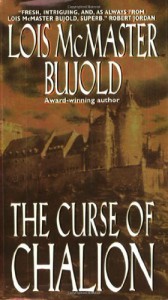 In The Curse of Chalion Lois McMaster Bujold, creates a fantasy world based on Reconquista Spain, a world shot through with divinity and magic. The hero, Cazaril, returning home from the wars betrayed by his superiors and broken in body and spirit, finds a new job as tutor-secretary to the royal heiress, and finds something new to believe in and care about as he attempts to guide her through political intrigue and family tragedy.
In The Curse of Chalion Lois McMaster Bujold, creates a fantasy world based on Reconquista Spain, a world shot through with divinity and magic. The hero, Cazaril, returning home from the wars betrayed by his superiors and broken in body and spirit, finds a new job as tutor-secretary to the royal heiress, and finds something new to believe in and care about as he attempts to guide her through political intrigue and family tragedy.
The world building in the book is well thought out and incredibly detailed. The magic in this world flows from the gods, and is often indistinguishable from miracles. The characters, even minor ones, are well fleshed out; even the villains have understandable motives and emotions. The main plot takes a little time to get rolling, but plenty is happening to keep the story moving along briskly, and the writing is compulsively readable.
Ms. Bujold has set two more books in this same world, Hugo award winner, Paladin of Souls (a direct sequel) and more distantly related, The Hallowed Hunt.
I’m a great Bujold fan, and will read whatever she writes, but this book is one of my favorites. Chalion is not a brand new book, but it is one worth suggesting to readers looking for a human story set against an epic background, or a fantasy grounded by very human characters.
Friday Reads: Fables by Bill Willingham
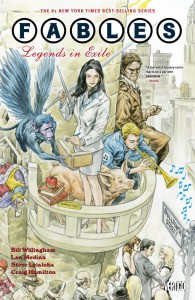 Fables is a multiple Eisner Award-winning comic book series written by Bill Willingham. It tells the story of characters from fairytales, folklore, and mythology who have been ousted from their homelands by the mysterious Adversary. They have been living in hiding in New York City for centuries, attempting to blend in with the non-magical human population. They stick together as a tight-knit community called Fabletown. Many of them live in an apartment building called the Woodland Luxury Apartments, which also houses the Business and Security offices of Fabletown, their own town hall and sheriff’s station. Any Fables who are unable to pass as human, such as animals or monsters or giants, live on The Farm in Upstate New York. Spells are in place to keep it hidden from Mundys, short for Mundane, the human natives of this world. People like you and me.
Fables is a multiple Eisner Award-winning comic book series written by Bill Willingham. It tells the story of characters from fairytales, folklore, and mythology who have been ousted from their homelands by the mysterious Adversary. They have been living in hiding in New York City for centuries, attempting to blend in with the non-magical human population. They stick together as a tight-knit community called Fabletown. Many of them live in an apartment building called the Woodland Luxury Apartments, which also houses the Business and Security offices of Fabletown, their own town hall and sheriff’s station. Any Fables who are unable to pass as human, such as animals or monsters or giants, live on The Farm in Upstate New York. Spells are in place to keep it hidden from Mundys, short for Mundane, the human natives of this world. People like you and me.
Well-known characters appear in the books, but with slightly different histories than you may remember. And of course, these tales take place long after the time of the stories we know, so things have changed quite a bit. Snow White and Prince Charming are divorced (he’s just TOO charming…and can’t resist sharing that charm with all the women he can); she is the Deputy Mayor of Fabletown, handling the day-to-day operations for the Mayor, King Cole; Bigby Wolf, aka the Big Bad Wolf, is the Sheriff. And we can’t forget Bufkin, the flying monkey librarian from Oz.
In the first collected volume, Legends in Exile, Snow White’s rebellious sister, Rose Red, has been murdered. So, the series introduces us to these unique characters through the telling of a complicated murder mystery, with the classic surprise ending.
A bit of a warning: these are not fairy tales for small children – there is a very bloody murder, sexual situations, and adult language. These books are definitely for a mature audience, teens and older.
The series isn’t new – it started in 2002 and is currently ongoing with monthly issues of the comic. Sadly, Willingham has announced that he will be ending Fables this year, with issue #150. But, it has been released in collected volumes, 20 so far. Each volume collects 5-12 issues of the comic book, making it very easy to start and catch up.
I’ve not caught up myself yet. But, I am really enjoying this interpretation of traditional fairy tales and stories. The characters are well developed and the writing makes you want to learn more about who they are and how they got where they are today. The artwork is very good, and incredibly detailed in many places. I may have spent way too long on the pages in the Business Office of the Woodland Apartments, which is magically larger on the inside than you would expect, trying to find every little detail of the accessories that the Fables brought from their Homelands to our world. I think that’s Excalibur in the stone back there…behind the Magic Mirror…and is that Captain Hook’s Jolly Roger floating by?
Friday Reads: Screaming at the Ump by Audrey Vernick
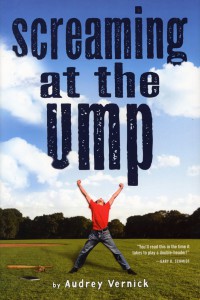
Baseball season is underway and many of us head out to the ball park when we can. Along that line of thought, the 2016 Summer Reading Program topic is about being active, with slogans “On Your Mark, Get Set, Read!,” “Get in the Game: Read” and “Exercise Your Mind – Read.”
(I know, the 2015 summer reading program is just getting underway, I am reading ahead now.) All of this brought me to read Screaming at the Ump by Audrey Vernick.
Casey Snowden’s father and grandfather run a sanctioned school for baseball umpires, and Casey (12) and his best friend Zeke help each fall. This September they have only 80 students instead of the usual 100 and Casey begins to worry about the future. He wants to be a sports writer, not run the camp, but he knows it is his father’s calling. As the school gets underway, Casey realizes one instructor is not teaching this year. He was usually in charge of the culminating event: “You Suck, Ump! Day” where many people from the town gather to yell at the students to help them learn to deal with noise and irritated fans. So this year Casey and Zeke will organize the day. Though I am not first in line for sports books, this one grabbed me, especially its title. A fun look inside the mind of a twelve-year-old boy, and at what it takes to be an umpire.
After reading the book I enjoyed looking over this page to find out more about actual umpire schools.
Friday Reads: Fabricated: The New World of 3D Printing by Hod Lipson and Melba Kurman

Despite being two years old this book by Hod Lipson and Melba Kurman is a great introduction to all of the major concepts behind 3D printing. Not only does it explain the technology but looks at different types of printing materials from ABS plastic to shortbread and 3D printing’s impact on everything from education to architecture.
Friday Reads: Mr. Penumbra’s 24-Hour Bookstore
 Robin Sloan has written a yarn that stretches from books to technology to ancient knowledge, typography to coded secrets, intrigue to cults, friendship to love. He uses historical facts combined with present day real life ‘Google” to take our champions on a quest for the “key to life”. Our main character, Clay Jannon, needs a job, and where does he land but the strangest bookstore he has ever set foot in. In the beginning Clay does what he’s told, but we all know rules need to be broken, the books must be read, so he does, and read them he cannot do. The bookshelves in this store are lined with volumes coded with puzzles, and Clay must find the key to solving them. He finds that the important codex vitae is 500 years old and is stored in a “cave” below a New York City corporation complete with black robes and solemn ceremonies. The capable Clay really does know where to find resourceful & talented friends, backers, and hackers. Together they form the Rebel Alliance as they become the warrior, the wizard, and the rogue.
Robin Sloan has written a yarn that stretches from books to technology to ancient knowledge, typography to coded secrets, intrigue to cults, friendship to love. He uses historical facts combined with present day real life ‘Google” to take our champions on a quest for the “key to life”. Our main character, Clay Jannon, needs a job, and where does he land but the strangest bookstore he has ever set foot in. In the beginning Clay does what he’s told, but we all know rules need to be broken, the books must be read, so he does, and read them he cannot do. The bookshelves in this store are lined with volumes coded with puzzles, and Clay must find the key to solving them. He finds that the important codex vitae is 500 years old and is stored in a “cave” below a New York City corporation complete with black robes and solemn ceremonies. The capable Clay really does know where to find resourceful & talented friends, backers, and hackers. Together they form the Rebel Alliance as they become the warrior, the wizard, and the rogue.
“You know, I’m really starting to think the whole world is just a patchwork quilt of crazy little cults, all with their own secret spaces, their own records, their own rules.” –Clay Jannon, Mr. Penumbra’s 24-Hour Bookstore.
Robin Sloan indicates that he is a media inventor. In his own words, he says a media inventor is “someone primarily interested in content—words, pictures, ideas—who also experiments with new formats, new tools, and new technology…. Media inventors feel compelled to make the content and the container.”
Do fantasy novels intrigue you? Does solving puzzles fit right up your alley? Do you want to go on your own quest? Have we maneuvered you into checking this out? Then our goal here is met.
Annette Hall & Janet Greser
Friday Reads: The Grammar Lady: How to Mind Your Grammar in Print and in Person
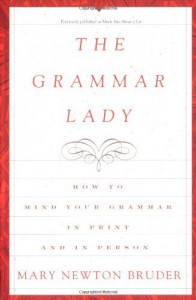 OK. I admit it – I’m a bit of a grammar snob. I know I’m opening myself up to criticism if I were to make a mistake. [Notice how I used the subjunctive – “were” not “was,” just now.] I ask for your sympathy. I attended a high school in eastern Pennsylvania that, in English classes from grades 9 through 12, we learned grammar, spelling, diagramming sentences, and vocabulary every year. The point I’m making here is, we had all this drummed into our wee heads, so we could not help but become somewhat obsessive about it. However, when I taught ninth-grade English in a high school in western Pennsylvania just four years later, there was no place in the curriculum for grammar – that’s how quickly matters had changed. (I taught some grammar anyway.)
OK. I admit it – I’m a bit of a grammar snob. I know I’m opening myself up to criticism if I were to make a mistake. [Notice how I used the subjunctive – “were” not “was,” just now.] I ask for your sympathy. I attended a high school in eastern Pennsylvania that, in English classes from grades 9 through 12, we learned grammar, spelling, diagramming sentences, and vocabulary every year. The point I’m making here is, we had all this drummed into our wee heads, so we could not help but become somewhat obsessive about it. However, when I taught ninth-grade English in a high school in western Pennsylvania just four years later, there was no place in the curriculum for grammar – that’s how quickly matters had changed. (I taught some grammar anyway.)
If you are interested in learning more about English grammar, spelling, vocabulary, and usage – and learning about these in a way that is perhaps more fun than the methods my classmates and I were exposed to – you couldn’t do much better than acquiring a copy of The Grammar Lady: How to Mind Your Grammar in Print and in Person, by Mary Newton Bruder. Starting a Web site in Pittsburgh entitled, “The Grammar Lady,” the author set herself up to answer any question that might be thrown at her related to grammar, whether directly or tangentially. I think she realizes that she is a bit of a grammar snob too, but she delivers her message in amusing ways with laugh-out-loud examples of how grammatical, spelling, vocabulary, and language usage mistakes can get in the way of communicating what one really wants to get across.
Bruder begins the book by laying out why grammar is important. Some of the major reasons:
- It can save time by keeping us out of situations (through misunderstanding or offense) that we later have to apologize for. [Yes, I know I ended that sentence with a preposition – excuse me!]
- It enhances communication.
- People are judged on the basis of their grammar (especially important during job interviews).
The author makes the point that students should be taught the basics of grammar by the third grade, and after that spend time refining that knowledge and learning vocabulary and more complex sentence structure. She also says it’s a waste [not “waist’] of time diagramming sentences. I disagree with that. [I really enjoyed learning to diagram sentences. I learned parts of speech by that method which, I think, helped with foreign languages too.]
One of my favorite aspects of this book is the amusing examples she offers of unintentional mistakes she sees in advertisements, company memos, school assignments, with many of these sent to her Web site. Here are a few:
- From a government-contract proposal: “We have ascertained that the project will require 66 man-moths of experience.”
- “The guest book is in charge of Mary Jane,” rather than as it should be, the other way around.
- “They referred a woman with a broken exhaust pipe and three flat tires.”
- “Hopefully it won’t rain tomorrow,” rather than “I hope it won’t rain tomorrow.” [Later in the book she describes this development as a battle that may already be lost.]
- The bugaboo of the parts of speech related to the verbs “lie” (meaning to recline), and “lay” (meaning to place something on a table, for example).
- A sportscaster and weatherman on a local television station described what they called a “heart-rendering” story.
In one sense I do the author a disservice. She may be a bit of an elitist, but she does allow for the fact that the English language does change, and that there is a difference between the written and the spoken language. However, there are some things she cannot abide, one of them being overuse of the word “like,” in a sentence such as, “It was . . . like . . . cold.” She refers to this as, an “inarticulate stutter,” all the while admitting that she has never seen it in print since it is mostly a bothersome habit of some speakers.
I recommend that you pick up this book – if you want to learn about grammar, spelling, vocabulary, language usage, and so forth, or if you just want to be amused at the many ways that we can mess up what it is we are trying to say to each other. For those who are interested, you may also want to look up another related book – Eats, Shoots & Leaves by Lynne Truss.
Friday Reads: Eat and Run by Scott Jurek
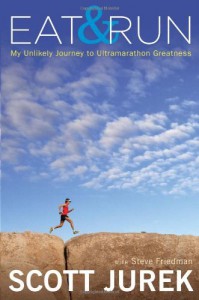 A few years back I discovered a documentary movie called Running on the Sun, about a brutal footrace called the Badwater 135 (that’s a 135 mile run through Death Valley, CA, in mid-July, often referred to as “the world’s toughest foot race”). If you have a chance, check it out. You can watch it all online, complete with German subtitles. It is a bit dated and there are other videos out there that might also be of interest (just do a search). Let’s just say up front that I never had any desire for these kinds of things, but after watching Running on the Sun, I became moderately interested in ultramarathon runners (defined as any running event that is longer than a marathon). My own running has waxed and waned over the years, settling on moderate amounts of mileage and hit and miss unstructured workouts. My interest in these ultra-events (sans particpation in them) extended to books and documentaries, including the self-promoting “Ultramarathon Man” Dean Karnazes. I don’t know if I’d describe him as outright arrogant or a just a peacock – the term given to guys who frequent running races or triathlons and strut around with their shirts off. I heard about another ultra guy named Scott Jurek when I read Christopher McDougall’s Born to Run, which seemed much less arrogant and peacock free.
A few years back I discovered a documentary movie called Running on the Sun, about a brutal footrace called the Badwater 135 (that’s a 135 mile run through Death Valley, CA, in mid-July, often referred to as “the world’s toughest foot race”). If you have a chance, check it out. You can watch it all online, complete with German subtitles. It is a bit dated and there are other videos out there that might also be of interest (just do a search). Let’s just say up front that I never had any desire for these kinds of things, but after watching Running on the Sun, I became moderately interested in ultramarathon runners (defined as any running event that is longer than a marathon). My own running has waxed and waned over the years, settling on moderate amounts of mileage and hit and miss unstructured workouts. My interest in these ultra-events (sans particpation in them) extended to books and documentaries, including the self-promoting “Ultramarathon Man” Dean Karnazes. I don’t know if I’d describe him as outright arrogant or a just a peacock – the term given to guys who frequent running races or triathlons and strut around with their shirts off. I heard about another ultra guy named Scott Jurek when I read Christopher McDougall’s Born to Run, which seemed much less arrogant and peacock free.
Jurek has written a book called Eat and Run. The appeal of Jurek is that he comes across as a down to earth modest guy, the antithesis of Karnazes. Jurek writes about his upbringing in Minnesota, candidly describing the care he gave to his mother during her suffering from multiple sclerosis. He also describes how he got started in the world of ultramarathon racing, and his climb to the near top, if not the top. The stories are entertaining, not just for the incredible racing feats, but because of the authenticity and humility that bleeds through in his writing. The other piece to Eat and Run is that Jurek only eats plant based foods, and some of his favorite vegan recipes are scattered throughout the book. Even if you are carnivorous and have no desire to change that fact, you might be motivated to try some of his recipes. I liked the Holy Moly Guacamole and Hemp Milk. Like many endurance athletes, Jurek has a great philosophy of life. A couple of notables:
“Every single one of us possesses the strength to attempt something he isn’t sure he can accomplish. It can be running a mile, or a 10K race, or 100 miles. It can be changing a career, losing 5 pounds, or telling someone you love her (or him).”
And:
“We all lose sometimes. We fail to get what we want. Friends and loved ones leave. We make a decision we regret. We try our hardest and come up short. It’s not the losing that defines us. It’s how we lose. It’s what we do afterward.”

